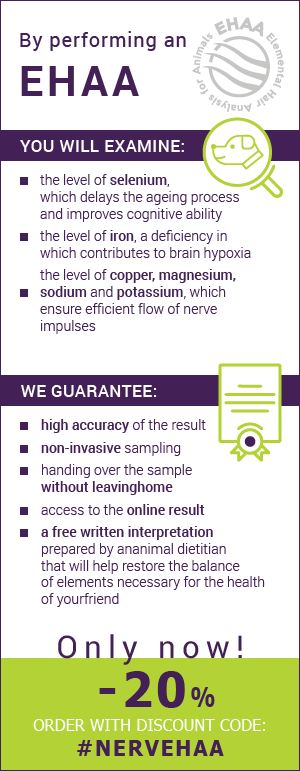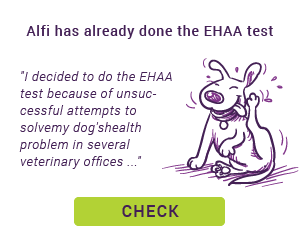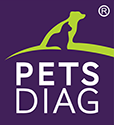The nervous system can be divided into central and peripheral parts. The central nervous system consists of the brain and spinal cord, while the peripheral has 12 pairs of cranial nerves and 36 pairs of spinal nerves. They innervate the muscles and internal organs, thus affecting the proper course of life processes, such as breathing and digestion. The nervous system is also responsible for receiving stimuli (from the environment and the body), and then processing and reacting to them appropriately. That’s why its proper functioning also affects your pet’s cognitive functions and behaviour. Hence, it’s worth providing a balanced diet and the necessary nutrients.
TRYPTOPHAN
Tryptophan is an amino acid – an organic compound of carbon, nitrogen and oxygen, which form part of proteins. It can be found in most products containing protein, but tryptophan is present in lower concentrations than large neutral amino acids (LNAAs) and competes with them to pass from the blood to the brain. Therefore, when it comes to high-protein diets, which consequently have a high amount of LNAAs, much less tryptophan can reach the brain. This is very important because tryptophan is a precursor to serotonin. This means that it’s crucial to serotonin production.
Serotonin, commonly known as the happy hormone, is a neurotransmitter that acts as a mood stabiliser and decreases reactivity in dogs. In addition, it regulates a range of important processes, such as blood clotting, digestion and cell maturation. It also impacts body temperature, blood pressure and sensitivity to pain, sound and touch. Serotonin deficiency leads to disturbances in the day-night cycle, loss of appetite, concentration problems, over-reactivity, disobedience, and even aggressive behaviour. When choosing dog food, it’s worth checking the protein content and origin. It’s recommended for your dog’s food to contain 18 – 20% protein, and for that protein to be of animal origin. Avoid products whose main source of protein is corn, because it contains only small amounts of tryptophan.
TYROSINE
Tyrosine is an endogenous amino acid, which means the body is able to make it on its own, as long as it’s given enough phenylalanine. One of the tyrosine’s tasks is participation in the synthesis of neurotransmitters, such as noradrenaline, adrenaline and dopamine. They’re responsible for stimulating the body and mobilising to action. Their high concentration in the blood is usually related to stress. The effects of this can include increased heart rate, increased blood pressure and dilated pupils. Tyrosine is also responsible for regulating pituitary and thyroid functions. It helps maintain physical fitness, prevents fatigue and allows the nervous and endocrine systems to quickly adapt to stress. The right level of tyrosine in the body improves concentration, as well as the ability to react and think quickly. Phenylalanine is necessary for tyrosine synthesis and can be provided to your dog in natural form through meat, fish and eggs.
GLUTAMINE
Glutamine is another endogenous amino acid, so some may think that it doesn’t need to be supplemented. However, research shows that in some situations, such as due to increased physical exertion, stress or chemotherapy, the demand for glutamine increases and the body is unable to produce enough. The best way to supplement this amino acid is using products of animal origin, such as beef, poultry and eggs because they contain a lot of good-quality protein. However, it should be remembered that under the influence of heat, glutamine is broken down into glutamate and ammonia. Currently, there are also special products containing this amino acid available on the market, and they can be mixed in with dog food.
An important role of glutamine is its participation (along with aspartate and glycine) in the production of gamma-aminobutyric acid (GABA), which is a neurotransmitter necessary for the proper functioning of the nervous system. In addition, it’s a very important amino acid for working and sporting dogs. Glutamine has a positive effect on the process of building muscle proteins by providing nitrogen and increases muscle endurance by protecting the body against glycogen loss. The great benefits of this amino acid include decreased muscle catabolism, which is the breakdown of muscle tissue. This translates into increased endurance and extended training duration.
ARGININE
Arginine is an amino acid that’s essential (exogenous) for dogs, which means that it must be supplied in food. Rich sources of this ingredient include most products containing animal protein, seafood and soya beans. In the body, arginine is used, among other things, in nitric oxide production. It’s a very important compound that in the central nervous system plays the role of a neuromodulator and affects memory and learning processes. On the other hand, in the peripheral nervous system, it impacts the peristalsis of the gastrointestinal tract. Arginine also takes part in the urea cycle, in which toxic ammonia is converted into urea. An arginine deficiency can, therefore, result in increased ammonia content in the blood and it getting into the nervous system. As a result, your dog may experience symptoms such as tremors, vomiting and over-agitation.
FATTY ACIDS
Fatty acids are comprised of the carboxyl group and the carbon chain. Fats are a natural source. In the body, they’re used as an energy source and a component of cell membranes. Due to their structure, fatty acids can be divided into saturated and unsaturated. Saturated fatty acids don’t have double bonds in the carbon chain. They include palmitic, stearic and lauric acid. Unsaturated fatty acids are further broken down into monounsaturated (contain one double bond in the carbon chain) and polyunsaturated (contain two or more double bonds). An example of a monounsaturated fatty acid is oleic acid, which belongs to the omega-9 family. Polyunsaturated fatty acids (PUFAs) from the n-3 and n-6 families play a crucial role in a dog’s diet. Similarly to other animals, a dog’s body is unable to produce them, and that’s why PUFAs must be supplied with food, for example, in the form of fish oils.
Acids from the n-3 family (eicosapentaenoic acid (EPA) and docosahexaenoic acid (DHA)) are particularly important for the nervous system. DHA is a key element in the process of development of nervous tissue and the retina of the eye. Studies have shown that supplementation with this acid in pregnant bitches has a positive impact on brain development in puppies. In addition, puppies that are given DHA after birth learn new commands faster. The beneficial effect of EPA and DHA can also be seen in older dogs. Adding these acids together with vitamin E, vitamin C and selenium delays ageing processes and improves cognitive abilities in seniors. For over-reactive or aggressive dogs, it’s recommended to decrease the content of protein and increase polyunsaturated fatty acids in food. They have a positive effect on reducing impulsive behaviour and have a clear sedative effect.

IRON
Iron is a microelement that forms part of haemoglobin – the erythrocyte (red blood cell) protein that transports oxygen from the lungs to all cells. Iron deficiency in the body leads to a decreased ability of erythrocytes to transport oxygen, thus hypoxia of the organs. An organ particularly sensitive to hypoxia is the brain – an interruption in the oxygen supply can cause severe brain damage and even brain death. Studies have shown that iron deficiency is most dangerous for dogs up to 18 months old. An insufficient amount of this element in the diet of such dogs leads to irreversible damage to the brain and problems learning new commands. Products of animal origin can be used as a source of iron. These include meat and offal (liver, spleen, lungs), or ready-made products.
SELENIUM
Selenium is a microelement that’s an antioxidant. Antioxidants are compounds that eliminate excess free radicals from the body and protect against the harmful effects thereof. A prolonged lack of antioxidants can lead to oxidative stress and contribute to, among other things, the development of heart disease, stroke or accelerated ageing. It’s also worth noting that selenium is used in treating symptoms of excessive nervousness, exhaustion and anxiety. Sources of this element include fish, meat and offal, such as kidneys and liver.
COPPER
Copper is another mineral that’s crucial for the proper functioning of the nervous system. It takes part in iron metabolism, controls the activity of neurotransmitters and neuropeptides, and participates in the formation of the myelin sheath. It surrounds the nerve fibres, providing mechanical protection, electrical insulation and faster flow of nerve impulses. A good source of copper are crustaceans and offal (liver, kidneys, heart). It’s also present in smaller amounts in turkey, duck, chicken and pork.
MACROELEMENTS
Macroelements that deserve special attention include magnesium, potassium and sodium. They participate in the conduction of nerve impulses and contractility of muscle fibres. Magnesium is also a stabiliser of the nerve cell membrane. A deficiency of this element can manifest in the form of excessive excitability, limb paralysis, and muscle tremors, while insufficient sodium and potassium can lead to decreased cell excitability. Meat can be used as a natural source of these macroelements, and in the case of potassium, brewer’s yeast is also an option. Magnesium is found mainly in bone tissue and legumes, but you can also use ready-made products that contain this element.
VITAMINS
Ingredients that impact the nervous system also include vitamins – mainly B-group vitamins. Vitamin B1 (thiamine) participates in the production of neurotransmitters, as well as in glucose metabolism, which determines the proper functioning of the brain. A thiamine deficiency can lead to neurological disorders and damage to the nervous system. Vitamins B2, B3 and B12 take part in many biochemical reactions in the body. Riboflavin (vitamin B2) affects the activity of nerve cells and erythrocytes, and a deficiency results in hypoxia of the brain and muscles. Niacin (vitamin B3) can be synthesised in dogs from tryptophan. However, as a rule, the amount of vitamin produced is too small to cover the daily requirement, and so it must be supplied with food. A niacin deficiency is quite rare but can occur in dogs fed food that doesn’t contain much vitamin B3 or tryptophan. In this case, symptoms such as decreased appetite, bloody diarrhoea and even degeneration of spinal cord neurons and impairment of conditioned reflexes appear. Brewer’s yeast should be used as a source of B-group vitamins. Niacin is also found in eggs, and thiamine in the liver, kidneys and port.
SUMMARY
The nervous system plays a key role in the body. It’s responsible for conducting nerve impulses between all cells, enables stimuli to be received from the environment and subsequent reactions, and controls the most-important life functions. Nervous tissue has poor regenerative capacity, and so it should be provided with all necessary nutrients. However, remember that before giving your dog supplementation, you should do the appropriate testing to figure out the right dose. In the case of minerals, this can be an EHAA, which determines nutrient concentrations in the body based on a hair sample.
Eng. Zootechnician, Katarzyna Żmuda
 1. Bosch G., Beerda B., Hendriks W. H., van der Poel A. F. B., Verstegen M. W. A. 2007. Impact of nutrition on canine behaviour: current status and possible mechanisms. Nutrition Research Reviews, nr 20, s. 180-194
1. Bosch G., Beerda B., Hendriks W. H., van der Poel A. F. B., Verstegen M. W. A. 2007. Impact of nutrition on canine behaviour: current status and possible mechanisms. Nutrition Research Reviews, nr 20, s. 180-194
2. Ceregrzyn M., Barszczewska B., Lechowski R. 2019. Podstawy żywienia psów i kotów. Wydawnictwo Edra Urban & Partner. Wrocław
3. DeNapoli J. S., Dodman N. H., Shuster L., Rand W. M., Gross K. L. 2000. Effect of dietary protein content and tryptophan supplementation on dominance aggression, territorial aggression, and hyperactivity in dogs. Journal of the American Veterinary Medical Association, nr 4, s. 504-508
4. Grela E. R. 2016. Behawioralne następstwa nieprawidłowego żywienia zwierząt. Życie Weterynaryjne, nr 91 (2)
5. Mirowski A. 2012. Selen w żywieniu psów i kotów. Magazyn Weterynaryjny, nr 12
6. Sobolewski J. 2018. Wpływ żywienia na zmiany zachowania psów. Animal Expert, nr 4
7. Sygocki C. Minerały i witaminy dla psa potrzebne do utrzymania pełni zdrowia. https://vetexpert.eu/blog/skladniki-mineralne-i-witaminy-czego-potrzebuje-twoj-piesdo-utrzymania-pelni-zdrowia
8. Witkowska O. 2015. Żywienie a behawior psów i kotów. Życie weterynaryjne, nr 90(9), s. 573-576















